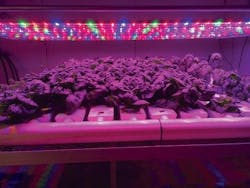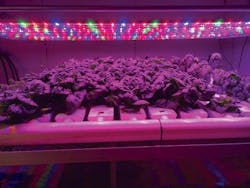ANSI/ASABE S642 will enable LED and module manufacturers to have products tested in a standard manner, and SSL product developers to have a measured way to compare products from different manufacturers.
The publication of S642 comes a bit more than a year after ASABE published the S640 standard that defined metrics specific to the horticultural applications. Most of the metrics that we commonly use in the SSL sector are attuned to the human visual system that has little correlation to what plants needs in terms of spectral energy.
The S642 document defines methods for testing what it calls “LED optical radiation devices” over the spectral range of 280–800 nm. As we have covered in prior articles on horticultural lighting, plants have sensitivity well beyond the human visual range and in fact beyond the PAR (photosynthetically active region) range of 400–700 nm.
Manufacturers following S642 will measure the radiant or photon flux of a device under test (DUT) using metrics defined in S640. Moreover, S642 requires that the manufacturer or test lab performing the testing capture the spectral power distribution (SPD) at a minimum of 5-nm increments across the 280–800-nm range. The standard specifies the use of a goniometer system combined with a spectroradiometer and sets forth accuracy requirements for such test equipment.
The S642 standard further requires measurement of performance changes over long-term use of LEDs in a horticultural setting. The requirements include changes in electrical power characteristics, and changes in radiant or photon flux of the DUT over time. The long-term testing must further be conducted in specified environmental conditions that would be typical in a horticultural setting, and the DUT must be operated at maximum rated current and at a lower current left to the manufacturer to choose. ASABE S642 requires a sample size of 20 packaged LEDs for each test or a sample size of 10 modules.
And as has been developed for general lighting, S642 affords methodology for projecting the performance of horticultural LED products beyond the required 6000 hours of actual testing. The new standard relies on the methodology developed in IES TM-21 and TM-28.
There is an entire section of the new standard dedicated to the equipment required for compliant testing of LEDs for horticultural applications. The final section of the standard details the requirements of reports produced by test labs working to S642. Standardization of reporting format ensures that SSL developers can easily compare data from different vendors.
The S642 standard concludes with several Annex sections. One such section focuses on the direction of light and acknowledges the fact that there are vast differences in horticultural lighting applications ranging from supplemental lighting in greenhouses to vertical farms to interlighting between plants. Another Annex includes considerations of measurements of LEDs and modules that utilize active cooling schemes.
The horticultural SSL sector has advanced rapidly in just a few years following many years of simple reliance on high-pressure sodium (HPS) lamps and just dealing with what those sources produced. LEDs offer so much more potential for customized spectrum, directional control, and precise on/off and dimming controls. But fixture developers/manufacturers — and ultimately growers — needed a metrology base that allowed the science to develop in terms of light recipes and more. And that advancement is happening.
The developments will further enable market transformation programs that can hasten the uptake of LED lighting in horticulture. As we wrote recently, the DesignLights Consortium (DLC) has recently released the measurement and documentation requirements that fixture manufacturers must adhere to for inclusion on the DLC horticultural QPL (qualified products list). Indeed, we had a presentation on those requirements at our recent Horticultural Lighting Conference. Watch for coverage of that conference in an upcoming issue of the magazine.
Meanwhile, ASABE has a third task force working on the third and final standard of its series of horticultural standards. The next standard will focus on horticultural efficacy. And it will take into account the many different ways horticultural lighting might be used to impact both growth and morphology.







